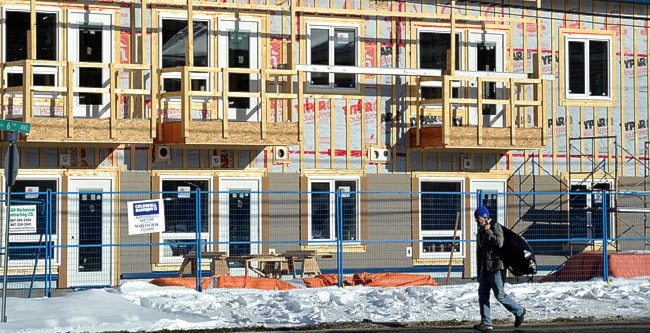At the end of the month, the 150 residents of the Bellavera Green condominium complex in Leduc, Alta., will be out on the street.
The building has been deemed unsafe by that city’s fire department.
A year ago, the first phase of the condo complex was granted “occupancy with conditions.”
One of those conditions was that the construction of the complex’s second phase would continue.
But late last year it was discovered that construction had ground to a halt.
“We did an inspection in December and realized the site had more or less been abandoned in the second phase of construction,” said Kevin Cole, who works for the City of Leduc.
Not only was the construction site left unsecured, but the existing building was rife with safety violations.
Both the fire alarm and the sprinkler system failed to meet provincial standards and some of the fire-separation barriers in the buildings had been damaged or removed.
The City of Leduc spent $150,000 trying to bring things up to code, but it wasn’t enough.
In the end, the city condemned the building and told the residents they would have to leave by March 31.
“We didn’t feel that there was any other choice but to issue the order,” said Cole.
“It’s unfortunate that a developer, that obviously had good intentions and what we felt looked like a feasible project, overextended himself, it appears.”
While it’s not the first time something like this has happened in Alberta, it is the first time it’s ever happened in Leduc.
But could it happen in Whitehorse?
Not likely, said Mike Racz, president of the Yukon Real Estate Association.
“There’s all sorts of stuff goes on down south that I think probably wouldn’t fly up here,” he said. “We’ve got contractors that have been here for 20, 30 years. They’ve got a pretty good track record.”
However, the city is growing, condos are popular and there are new contractors in town, said Mike Gau, Whitehorse’s manager of planning and development services.
But so far, he said, there haven’t been any problems.
“It’s not that it couldn’t happen here; it’s just kind of a ridiculous scenario,” he said.
Every new building goes through a formal inspection and permitting process.
There are between five and seven inspections on a typical building, said Gau.
It’s the builder’s responsibility to arrange for inspections of things like plumbing and electrical, as construction progresses.
“If you proceed without that inspection, depending on what it is, you can be asked to remove (what you’ve done),” said Gau. “So if you cover up vapour barrier, for example, depending on the situation, inspectors can force you to remove the drywall.”
It’s not something that inspectors like to do, but they will if they have to, said Doug Thorseth, the City of Whitehorse supervisor of building inspections.
“We hope it never comes to that, but it has happened on occasion,” he said.
Far larger, more complex buildings go through the same process, but inspectors also rely on field reviews and letters of design assurance from the professionals - architects and engineers - who worked on the project.
“We know, with their signature, everything is above board and it fits their design,” said Thorseth.
Once the inspections are complete, the builder then needs to apply for an occupancy permit.
“Occupancy would not be granted unless the health and safety items were completed,” said Gau. “There’s one permit after occupancy which is the final permit.”
Usually that final permit deals with finishing off things, like railings and decks.
It’s rare for problems to arise during that stage, but it does sometimes happen.
Last summer the $4.85-million seniors’ complex in Watson Lake ran into problems when it was discovered the balconies didn’t meet fire code standards.
It was a relatively easy fix. All it took was a coat of fire-retardant paint.
The fire code violations for the building in Leduc were much more severe.
It’s a contingency that’s almost impossible to plan for, said Gau.
“If someone were to tear something out after inspection, that really has nothing to do with the city,” he said.
In his more than two decades as a building inspector, Thorseth has never seen anything like what happened in Leduc, although he has heard of stories of unscrupulous behaviour.
During Regina’s construction boom in the 1970s, there was one contractor who had built several houses without insulation in the walls, he said.
“What he was doing was pulling out the poly insulation on each house and reusing it and reusing it and reusing it,” said Thorseth. “This happened until one of the inspectors noticed that he’d seen that exact piece of poly before.”
In the Yukon, as in Alberta, it’s really buyer beware.
“I imagine it’s that way almost everywhere,” said Brenda Wale, communications analyst for the Department of Community Services. “You have to be careful about entering into contracts and really do your homework.”
While the residents of the Bellavera Green condominium have to be out by the end of the month, the court has appointed a receiver armed with $1 million to figure things out.
For its part, the City of Leduc will be examining its policies, said Cole.
“When this all gets sorted out, I think we’ll sit down and look at lessons learned,” he said. “It’s difficult to say whether we could have improved any of the processes.
“We definitely will look at phasing of buildings and how occupancy is granted.”
Contact Josh Kerr at
joshk@yukon-news.com
